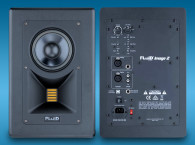PreSonus has announced the new R65 and R80 Active AMT Monitors, featuring a custom Air Motion Transformer (AMT) tweeter, driven by a 50W RMS Class D amplifier, and 6.5/8-inch woofers driven by 100W RMS Class D amplifiers and featuring Acoustic Tuning controls. PreSonus also introduced recently the new Eris E44 and E66 two-way active MTM (Midwoofer-Tweeter-Midwoofer) studio monitors, providing a wider stereo field.

Already with an interesting and innovative range of active studio monitors at reasonable prices, each one featuring different types of drivers and designs, PreSonus apparently believes in delivering different options to the market and has recently expanded its nearfield options with two new monitor models - each one featuring two different sizes/power combinations.
 PreSonus’ new R65 and R80 active studio monitor speakers offer a custom Air Motion Transformer (AMT) tweeter, which delivers an extremely fast transient response to provide exceptionally detailed resolution. These biamped monitors feature Class D power amplifiers, with 100W RMS driving the woofer and 50W RMS driving the AMT tweeter, making them some of the most powerful monitor speakers in their category. As with all PreSonus studio monitors, both models are equipped with the company’s lauded Acoustic Tuning controls.
PreSonus’ new R65 and R80 active studio monitor speakers offer a custom Air Motion Transformer (AMT) tweeter, which delivers an extremely fast transient response to provide exceptionally detailed resolution. These biamped monitors feature Class D power amplifiers, with 100W RMS driving the woofer and 50W RMS driving the AMT tweeter, making them some of the most powerful monitor speakers in their category. As with all PreSonus studio monitors, both models are equipped with the company’s lauded Acoustic Tuning controls.Both the R65 and R80 employ a 6.8-square-inch AMT tweeter that responds to the subtlest waveforms and high frequencies, making them an ideal choice for hearing ultra-highs that add “air” and a sense of space. PreSonus R-series monitors offer wide lateral dispersion for a broad “sweet spot,” along with very narrow vertical dispersion, which helps reduce ceiling reflections that can muddy the sound. This helps to minimize room anomaly interference, providing a more consistent sound in different listening environments.
The R65 employs a 6.5-inch, coated Kevlar woofer, while the R80 sports an 8-inch woofer. This design, according to the company, results in cohesive, less time-smeared audio with minimal coloration and extremely punchy bass. The Acoustic Space switch controls a second-order, low shelving filter that helps to compensate for the boundary bass boost that occurs when the monitor is placed near a wall or corner. An HF-driver level control is also provided to help mitigate room problems. An onboard 4-position high-pass filter makes it easy to integrate a subwoofer into any type of monitoring setup.
The new R-series monitors feature balanced XLR and 1/4” TRS and unbalanced RCA input connections, as well as safety features like RF shielding, current-output limiting, over-temperature protection, and subsonic protection. Frequency response is rated at 50 Hz to 25 kHz for the R65 and 45 Hz to 25 kHz for the R80. An optional amplifier Standby function helps conserve energy.
New MTM Monitors
Introduced just two weeks prior to their new R-Series, PreSonus’ new Eris E44 and E66 MTM monitors are two-way active speakers, intended to deliver an expanded frequency range and the widest stereo field in their class, thanks to their nested Midwoofer-Tweeter-Midwoofer design (also known as “D’Appolito” in reference to Joe D’Appolito’s AES paper published in October 1983. Even tough he never claimed to be the first one to use this configuration - the MTM configuration mentioned in US Patent 8,170,233, assigned to Harman, quotes D'Appolito in that regard).

The E44 and E66 nested MTM configuration provides a more consistent listening experience on- and off-axis and incorporates dual Kevlar low/mid drivers (4.5- and 6.5-inch, respectively) operating in parallel and covering the same frequency range so that they acoustically couple. This effectively creates a larger woofer to provide a more dynamic output than conventional two-way studio monitors. According to the Baton Rouge, LA, company “nesting a 1.25-inch, silk-dome, high-frequency driver between the two woofers minimizes phase displacement to improved spatial resolution and a wide sweet spot.”
 Like all PreSonus’ Eris speakers, the E44 and E66 provide the tools needed to suit different mixing environments. By bringing the midrange drivers close together and raising the HF driver, the E44 and E66 are able to perform optimally in both horizontal and vertical orientations. A three-position Acoustic Space switch helps compensate for the boundary bass boost that occurs when the monitor is placed near a wall or corner, while high and mid acoustic tuning controls further help to mitigate room problems. A Low Cutoff filter also makes it easy to integrate a subwoofer.
Like all PreSonus’ Eris speakers, the E44 and E66 provide the tools needed to suit different mixing environments. By bringing the midrange drivers close together and raising the HF driver, the E44 and E66 are able to perform optimally in both horizontal and vertical orientations. A three-position Acoustic Space switch helps compensate for the boundary bass boost that occurs when the monitor is placed near a wall or corner, while high and mid acoustic tuning controls further help to mitigate room problems. A Low Cutoff filter also makes it easy to integrate a subwoofer.

Like the R-Series, the new Eris E44 and E66 studio monitors feature individual balanced XLR and 1/4” TRS, and unbalanced RCA input connections, as well as RF shielding, current-output limiting, over-temperature protection, and subsonic protection.
Eris E44 and E66 studio monitor speakers are available for $249.95/speaker and $349.95/speaker, respectively. The PreSonus R65 and R80 are also available for U.S. MAP/street prices of $399.95 and $499.95, respectively.
The R65 and R80 and the new Eris E44 and E66 MTM monitors expand PreSonus range of studio monitors, which also includes the Ceres C3.5BT and C4.5BT featuring Bluetooth wireless and flexible I/O for home use; the Eris E4.5, E5, and E8, for personal studios; the Sceptre S6 and S8 coaxial monitors; and the Temblor T8 and T10 active studio subwoofers.
www.presonus.com/products/monitoring






